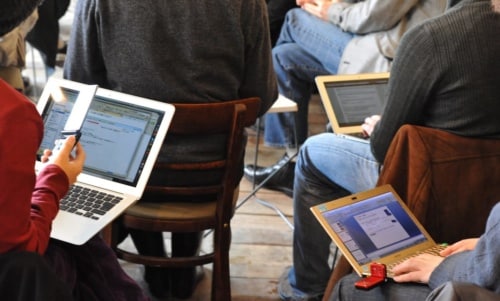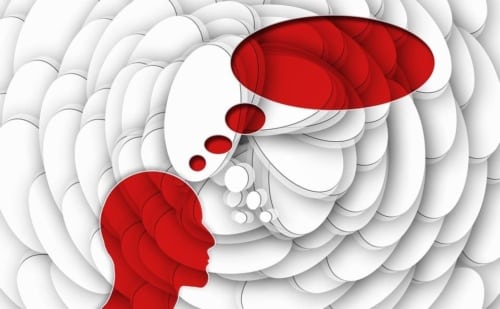Part 4: Digital learners prefer parallel processing and multitasking by Ryan L. Schaaf
 Series Synopsis: Due to continuous digital bombardment and the emergence of the new digital landscape, today’s youth process information, interact, and communicate in fundamentally different ways than any previous generation before them. Meanwhile, many of us, having grown up in a relatively low-tech, stable, and predictable world, are constantly struggling with the speed of change, technological innovation, and the freedom to access the overwhelming sea of information online – all defining characteristics of the digital world of both today and the swiftly-approaching future.
Series Synopsis: Due to continuous digital bombardment and the emergence of the new digital landscape, today’s youth process information, interact, and communicate in fundamentally different ways than any previous generation before them. Meanwhile, many of us, having grown up in a relatively low-tech, stable, and predictable world, are constantly struggling with the speed of change, technological innovation, and the freedom to access the overwhelming sea of information online – all defining characteristics of the digital world of both today and the swiftly-approaching future.
Based on the award-winning book, Reinventing Learning for the Always-On Generation: Strategies and Apps That Work, this 12-part article series will provide a comprehensive profile of nine core learning attributes of digital learners, and the core teaching, learning, and assessment strategies that can be used to appeal to their digital lifestyle and learning preferences. Readers will gain a clear understanding of various research-based strategies to optimize learning for the digital generation in the new digital landscape.
Part 4: Attribute #2: Digital learners prefer parallel processing and multitasking
“When we think we’re multitasking we’re actually multi-switching. That is what the brain is very good at doing – quickly diverting its attention from one place to the next. We think we’re being productive. We are, indeed, being busy. But in reality, we’re simply giving ourselves extra work.”
– Michael Harris, Writer
There have been great concerns expressed about the inability of the digital generations to follow long and complex arguments. The rapid access, skim-and-leave reading behavior fostered by surfing the Internet, coupled with the multitasking mindset that is common in the digital world today, has made the digital generations less likely to work their way through documents that require a patient approach to follow longer, more challenging thoughts, opinions, and arguments.
From the very earliest of times, people have always been able to multitask. Technically, it’s called continuous partial attention—where we randomly switch between tasks, deciding which one to do next, and time-slice our attention. We do it every day. We drive down the highway, listen to the radio, think about what we will do during the day, carry on a conversation with a passenger.
 With the digital generations, this multitasking all happens much faster. The digital generations are sending text messages, watching Internet videos, listening to downloaded playlists of music, talking on smartphones, looking at brightly colored flashing websites, sending instant messages, and generally counting on the Internet as their external brain. As a result, their minds must continually skim and skip between tasks to keep up. This butterfly brain effect can be a real challenge when educators are trying to get students to focus on important tasks or employers are trying to get workers to focus on their jobs.
With the digital generations, this multitasking all happens much faster. The digital generations are sending text messages, watching Internet videos, listening to downloaded playlists of music, talking on smartphones, looking at brightly colored flashing websites, sending instant messages, and generally counting on the Internet as their external brain. As a result, their minds must continually skim and skip between tasks to keep up. This butterfly brain effect can be a real challenge when educators are trying to get students to focus on important tasks or employers are trying to get workers to focus on their jobs.
What the research says is that effective multitasking is really about having a good memory, capable of being able to pay attention to several familiar tasks at one time, while also being highly adept at task-switching. This isn’t the way the older generations grew up. This is not what most of us experienced as children.
Do you remember when your parents might have said…? Stop listening to that music or watching the TV while you study. They said the best way to study was to isolate yourself from the TV, the radio or CD player, and the world outside your window. They also insisted to study effectively, you needed to clear an uncluttered study space with a comfy chair, good lighting, and plenty of space.
 Compare that approach and traditional mindset to the way that the digital generations function today. How many of you have walked into a kid’s bedroom recently? They are, working on a tablet, earbuds dangling around their neck cranking out the music of some band you’ve never heard of before called Brain Enema or Baby Metal, their hand reflexively tapping to the backbeat of the song. Meanwhile, they’re also doing their homework, watching a YouTube video, tweeting a friend, downloading some music and an image from Google, and cybershopping, while they’re simultaneously carrying on two conversations on Instagram about last night’s episode of the Walking Dead. And if you ask them, they’ll tell you they’re still bored! They’ll also tell you they have to play their music loud because it helps them concentrate—something that many of the older generations simply can’t fathom.
Compare that approach and traditional mindset to the way that the digital generations function today. How many of you have walked into a kid’s bedroom recently? They are, working on a tablet, earbuds dangling around their neck cranking out the music of some band you’ve never heard of before called Brain Enema or Baby Metal, their hand reflexively tapping to the backbeat of the song. Meanwhile, they’re also doing their homework, watching a YouTube video, tweeting a friend, downloading some music and an image from Google, and cybershopping, while they’re simultaneously carrying on two conversations on Instagram about last night’s episode of the Walking Dead. And if you ask them, they’ll tell you they’re still bored! They’ll also tell you they have to play their music loud because it helps them concentrate—something that many of the older generations simply can’t fathom.
In his book Brain Rules, John Medina (2008) tells us that research on multitasking indicates that contrary to what the digital generations might believe, multitasking modern students are not nearly as effective at concentrating on a particular task as those who single task. In fact, humans are biologically incapable of processing multiple information-rich inputs simultaneously. Medina says that the effect of multitasking on productivity is like trying to get something done after you’ve had several stiff drinks. We might think we are doing very well, but in reality, we’re slower and sloppier, and we make many more mistakes. His studies show clearly that someone who is regularly interrupted takes 50 percent longer to complete a task and makes up to 50 percent more errors.
In iBrain, Gary Small and Gigi Vorgan (2008) point out that while multitasking is an essential skill in the digital world, to minimize the negative aspects of doing multiple tasks simultaneously, we must balance multitasking with strategies for developing single-tasking skills: “Multitasking has become a necessary skill of modern life, but we need to acknowledge the challenges and adapt accordingly. Several strategies can help, such as striving to stay on one task longer, and avoiding task switching whenever possible” (p. 69).
 In Brain Rules, Medina (2008) says that educators need to acknowledge that multimedia multitasking is an everyday reality of life—that students do not suffer notable cognitive shortcomings as they multitask; rather, they are learning more, and they are more adept at finding answers to deep questions, in part because they can search effectively and access collective intelligence. And Medina cautions that the solution to the challenges of multitasking is not just to remove technology and other distractions because they are too intricately woven into the digital generations’ lives.
In Brain Rules, Medina (2008) says that educators need to acknowledge that multimedia multitasking is an everyday reality of life—that students do not suffer notable cognitive shortcomings as they multitask; rather, they are learning more, and they are more adept at finding answers to deep questions, in part because they can search effectively and access collective intelligence. And Medina cautions that the solution to the challenges of multitasking is not just to remove technology and other distractions because they are too intricately woven into the digital generations’ lives.
The bottom line is that whether we like it or not, and whether we think it was better back then or not, we’re never going back to 1985 or even 2005. The problem is that there are parents, politicians, lawmakers, and even some educators who continue to promote an educational model and prepare students for a world that no longer exists.
In the next installment of the series, we will explore learning attribute #3 – Digital learners prefer processing pictures, sounds, color and video before they process text.
Read additional articles in the series:
Reinventing Learning for the Always-On Generation – Part 1
Reinventing Learning for the Always-On Generation – Part 2
Reinventing Learning for the Always-On Generation – Part 3
Ryan Schaff was one of hundreds of educators and experts to speak at FETC 2018 in January. From now through April 30, educators can submit proposals to speak at the 2019 conference in Orlando. Learn more here and submit your speaking proposal
Author
 As a professor, author, blogger, consultant, and keynote speaker, Ryan L. Schaaf wants to help educators reach the learners of the digital generations.
As a professor, author, blogger, consultant, and keynote speaker, Ryan L. Schaaf wants to help educators reach the learners of the digital generations.
His book, Reinventing Learning for the Always-On Generation: Strategies and Apps that Work co-authored with Ian Jukes and Nicky Mohan, recently received an IPPY Award for its contributions as a resource book for educators.
You can find Ryan on MyEdExpert.
Follow Ryan Schaaf on Twitter
Further Reading
- edCircuit –Part 3: Digital learners prefer receiving information quickly
- UCLA Newsroom – Distractions diminish people’s ability to remember, but important facts still stick
- Oxford Learning – Is multitasking bad for students?
